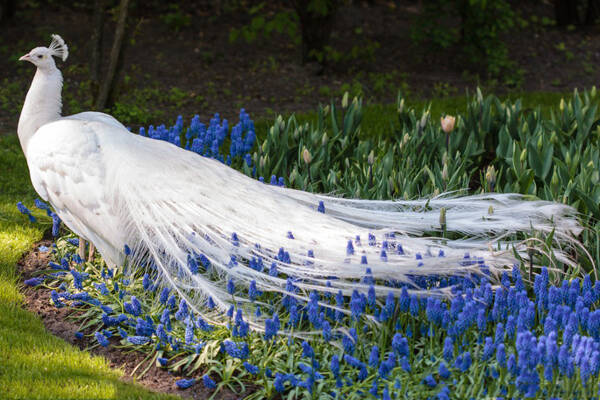Pavo cristatus
IUCN
LCBasic Information
Scientific classification
- name:Pavo cristatus
- Scientific Name:Pavo cristatus
- Outline:Landfowl
- Family:Galliformes Gallinae Phasianidae Peacock
Vital signs
- length:About 1.85 meters
- Weight:Up to 25kg
- lifetime:About 20 years
Feature
The whole body is pure white without any other colors, and it is a variant of the blue peacock.
Distribution and Habitat
In India and Sri Lanka, the white peacock is similar to other peacocks and likes to live in hilly forests, dry semi-desert grasslands, shrubs and deciduous forests, especially near water.
Appearance
The whole body is pure white, the feathers are plain, and the eyes are light red.
Details
The scientific name of the white peacock is Pavo cristatus. It generally refers to a variant of the wild blue peacock bred under artificial breeding. It is rare and is an extremely precious ornamental bird. However, after artificial domestication, it has reached a state of self-sustaining population.

There are only two species of peacocks in the world: Indian peacock (also known as blue peacock) and Java peacock (also known as green peacock). Some scholars also list the white peacock as another type of peacock. In fact, the white peacock is a variation of the Indian peacock. Therefore, the white peacock is not an independent species. Since the white peacock is a variation of the Indian peacock, zoologists generally believe that the ancestral home of the white peacock is in India and Sri Lanka. Today, white peacocks are also common in various zoos.
The white peacock follows its flock to the fields to forage in the early morning and evening. It likes to build nests on the ground, but roosts in trees. The white peacock's diet is mainly plant-based feed, and it also eats locusts, crickets, moths, termites, frogs, lizards and other animals. In captivity, it mainly eats corn, wheat, bran, sorghum, soybeans, soybean cakes and grass, plus fish meal, bone meal, salt, gravel, multivitamins, trace elements, amino acids, additives, etc. according to the feeding situation. It likes to eat fruits such as pears and yellow bubbles, and also eats rice, sprouts, grass seeds and other foods. In addition, it also eats some insects such as crickets, locusts, etc., and some small reptiles. Animal food is mainly termites. But in the wild, white peacocks also eat young cobras.
White peacocks have underdeveloped wings and are not good at flying, but their feet are strong and powerful, so they are good at running fast. When they flee, they usually run in big strides. They usually forage in the early morning and evening. In the early morning, they come to the stream to drink water and clean their feathers, and then go to the woods to forage together. At the hot noon, they rest in the shade of the forest and feed again at dusk. At night, they fly to the branches to rest.

The white peacock is a polygamous bird, with each male living with about five females. The breeding season of the white peacock is from April to August. During the breeding season, the male bird is very fierce and will even attack its own image in the mirror. The male birds frequently spread their feathers between 8:30 and 9:30 in the morning and between 4 and 5 in the afternoon, competing with each other, shaking their feathers and making noises. They also make loud "ah-oh, ah-oh" calls like a trumpet. When the female peacock is in estrus, she squats down, and the male peacock jumps on the back of the female peacock to mate. When mating occurs, the male peacock pounces on the back of the female peacock, bites the top of the female peacock's head with his beak, and keeps stepping on the back of the female peacock with his two feet alternately. The back of the body shakes greatly, and the female peacock's tail feathers spread out, actively accepting the male peacock's mating action. The entire mating time is about ten seconds. Then they leave. The female peacock lays 4-8 eggs each time, the egg white color is to cream yellow, and the incubation period is 28 days. Only the female bird participates in the incubation. The feathers of the chicks are light brown, and the color of the back is slightly darker. The feather color of the immature juveniles is similar to that of the female bird. Sexual maturity is reached after two to three years.
The white peacock is a variant of the blue peacock bred under artificial breeding, with a mutation rate of about 1/1000, which is relatively rare. This is mainly due to the low frequency of gene mutation. In addition, in the eyes of female peacocks, the monotonous color of male white peacocks is not as attractive as the colorful blue and green peacocks. But after artificial domestication, the white peacock has reached a state of self-sustaining population.
In my country, only the green peacock is a protected animal, and the blue peacock and the white peacock are not protected animals in my country.
Protect wild animals and stop eating game.
Maintaining ecological balance is everyone's responsibility!








